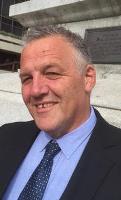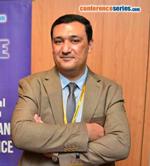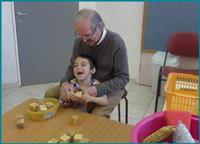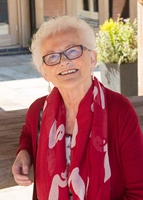Day 2 :
Keynote Forum
Michele Attias
Michele Attias Coaching, UK
Keynote: Look Inside: Stop Seeking Start Living
Time : 12:00-12:35

Biography:
Michele Attias is a mindset expert working for over 20 years within the mental health field. She completed her Advanced Diploma in Therapy at North London University, Qualified as a Clinical Supervisor at the Central School for Counselling and Psychotherapy London, studied at the prestigious Tavistock Clinic studying a masters in Child and Adolescent Psychotherapy, and further on Completed a Coaching Certification. She has Clinically supervised the client caseloads for over 60 therapists and worked with highly complex clients. She has published more than 100 articles on Personal Development with 4 different online publications with a readership of over 35,000. She is an international Speaker, has been featured on podcasts, international radio shows, and has published her book ‘Look Inside: Stop Seeking Start living’on Amazon. In 2014 she was a finalish in the Women Inspiring Women Awards, and in 2017 was a Best Coach finalist at the Best Business Women Awards.
Abstract:
Statement of the Problem: Professional Men and women who overthink life, making them feel overwhelmed, unfocused, stressed, anxious and with poor decision making process.
They appear successful externally, because they are chasing what is outside of them (money, business, relationship) to make them feel secure. They are scared to feel, to connect and to simply stop, as the overthinking overwhelms and paralyses them. With 60,000 thoughts each day, and 48 thoughts each minute, the compulsion to attach to certain thoughts, sabotage and keep them not only from further success, but from their internal wellbeing.
From 6- 12 weeks, I help clients transition from overthinking, anxious, unfocused, often living in a whirlwind of stress, to having laser-focus, clear decision making, feeling more connected, purposeful, focused and relaxed – they even start to enjoy life more.
Using empathic understanding to listen to the clients story. Teasing out themes that have underpinned their life, whilst building trust to ensure a robust platform for commencing our work together. Gaining clarity on what they want to create so that we have a strong anchor that directs the direction of the work. Challenging assumptions, internal stories, beliefs, limitations and thoughts. This is done initially by being mindful of the language and words used in their speech. Attention spent towards what brings joy and energises their life. Eliminate the areas that deplete their life and aim to do more of what energises them, whilst giving them tasks to do in between sessions to build on. Mindset shifts from overthinking to taking purposeful action when need be. Moving them from thought paralysis to taking action. Identifying their internal resourceful nature. Testing and exploring their more powerful mindset. Shifting their mindset from passive to active. Shifting mindset from victim to owner. Energy which used to be reactive and angry dissipates. Comfort zone expands, becoming more comfortable with uncertainty, productive and stress-free. These programme are combined with coaching audios and resources in between sessions, but it is by no means prescriptive and will be bespoke and depend on what changes the clients want to make. I will propose at our consultation how long I recommend we work together based on what they share with me.
- Mental Health - Reseach and Development | Bipolar Disorder | Mental Health Treatments | Emotional Intelligence | CBT | Womens Mental Health | Mental Health Therapies | Psychosis | Rehabilitation
Session Introduction
Laryssa M. Creswell
St. Elizabeths Hospital, USA
Title: Critical Ethnography & Black Feminism: Inside Perspective of Treatment for Women with Co-Occurring Disorders in the Psychiatric Hospital

Biography:
Dr. Creswell earned her Doctor of Education in Counseling Psychology from Argosy University/Washington DC. She is a board certified music therapist and a licensed clinical professional counselor who has worked in the field of mental health in various settings for the past 15 years. Prior to moving into an administrative role, she spent 11 years as a music therapist working with children, adolescent, adult and geriatric populations. She has a wealth of knowledge in program development and has a long standing interest in developing and modifying treatment provisions for women with severe and persistent mental illness, trauma, and substance use disorders. She has conducted research on women’s perspectives of treatment in the psychiatric institution with plans to conduct further research. Dr. Creswell is invested in creating a robust gender-responsive program for women with co-occurring disorders receiving treatment in psychiatric institutions and to enhance their therapeutic treatment experience.
Abstract:
The purpose of this presentation is to explore the perspectives of women diagnosed with co-occurring disorders on the treatments provided by a state psychiatric hospital so that appropriate recommendations for changes in treatment may be made. In the study Critical ethnography was used and the data was viewed through the lens of intersectionality from the black feminist perspective. Seven women hospitalized in one psychiatric hospital in the Mid-Atlantic region participated in the study. Data was collected via semi structured interviews, Consumer Perceptions of Care survey, researcher's observations, and archival data. Three major findings emerged: (1) Dialectical Behavioral Therapy (DBT) was identified as a beneficial treatment, (2) a lack of trust in the system and people in the system, and (3) housing or homelessness was perceived as a barrier. Based on the results of this study, it is recommended clinicians, administrators, and policy makers listen closely to individuals receiving treatment to make decisions regarding treatment accordingly.

Biography:
Stefan has been in full time private practice for over fifteen years. He has delivered trainings on various topics including Anger Management, Gestalt therapy, Architypes and Psychodrama. He is a BACP, accredited psychotherapist and counselling supervisor. Also, a facilitator within MKPUK https://mankindproject.co.uk/ and the Portsmouth community of “A Band of Brothers” www.abandofbrothers.org.uk (Mentoring for young offenders).He is the author of “The Penny Model” www.thepennymodel.com and originator of the “Break Free Anxiety” phone app.
Abstract:
Statement of the problem: Failing to understand what our emotion are for. Many people struggle with an excess of one emotion or another which is commonly named as a “Mental Health” issue or “Disorder”. Carrying such titles or beliefs can compound the dynamic and result in long term dependency on health professionals, medication and others, instead of accessing internal resources and looking for the antidote for an excessive or undesired emotion.
Depression is a symptom of dis-ease and we will look at the cause/solutions.
Clients need something tangible and accessible to be able to comprehend/cognise, that what is being experienced is a normal human experience whilst not desired or always healthy. The normalisation of fear and all emotions is transformative. Those working within emotional wellbeing/health sector, need to reduce the use of the term “Mental Health” or “Disorders” and change it to an excess of an undesired emotion. The DSM-I, from 1952, listed 106; the DSM-III, from 1980, listed 265, and the current DSM-IV has 297, with an ever-increasing list of medications from the Pharmaceutical Companies.
But we only have four primary emotion’s (and one secondary). Attending to the primary emotions with a clear framework can eliminate most of the top-heavy diagnosis and offer more normality to a human experience. A new and accessible look at our core emotions through the lens of “The Penny Model”, can facilitate this. Offering a accessible framework for the practitioner and clients with the use of metaphor and illustrations of how each emotion is connected to others as well as the message is from each emotion.
Aboelezz M. Kalboush
Alnoor Specialist Hospital, Egypt
Title: Interviewing a case of conversion catatonia as a new treatment approach

Biography:
Dr. Aboelezz Kalboush is an Egyptian consultant psychiatrist, He works in General secretariat of Mental Health and Addiction Treatment , EGYPT. He completed his Master degree in psychiatry & neurology from Ain-Shams university , Egypt in 2007 , Arab Board in psychiatry in 2007 and Egyptian Board in psychiatry in 2008. He is the head of psychiatry department in Alnoor Specialist Hospital, Saudi Arabia since June 2013 . He is responsible for training of medical students (both undergraduates & postgraduates) in psychiatry.
Abstract:
Catatonia is a state of psycho-motor immobility and behavioral abnormality and the sufferers are usually unresponsive, rigid, mute and only appear to be conscious. Muteness is an obstacle to collect a history from patients suffer from catatonia. After collecting a relevant history and information from the family of a 55 years old lady who was suffering from catatonia came to my clinic after doing thorough medical and neurological investigations with no abnormal findings, I started interviewing this patient in a structured way like any other psychiatric patient ,mainly to inform her about what I was going to do to help her in terms of her management plan . Although I was not expecting at all to get any response from her ; there were two reasons behind my approach , the first is that unresponsiveness of the sufferers of catatonia is not an enough reason to discriminate against them by ignoring their presence in our clinics and to deal with them as ( non-living objects ). The second reason was to see if interviewing a patient with a conversion catatonia has a positive impact on her treatment and the prognosis of her disorder. Methodology : Case study with literature review of the neurophysiology of catatonia and its management. Findings : Apart from the rapid and dramatic response to the treatment that included benzodiazepines and continuous interviewing of the patient during the catatonic state till complete recovery within 3 days and stabilization of condition for more than 11 months without relapse , a new and unexpected different good findings appeared on recovery that couldn't be explained only by using of benzodiazepines . Conclusion & Significance : Although the sufferers of catatonia are mute and unresponsive , but their brains are still working and able to process the incoming data through different senses , and this is shown both clinically ( e.g. echolalia , echopraxia , . . . etc.) and by functional brain imaging. So - theoretically – patients suffer from catatonia can benefit from supportive ,explanatory and psycho-educating interviews . By replicating this approach with patients of catatonia - of psychiatric origin – and by linking the clinical results of these case studies or case series with results of brain imaging of patients involved in those studies we can validate and understand the nature and importance of this suggested approach.
Nabila El-Zanaty
PsycheMe Ltd and Improving Access to Psychological Therapies (IAPT) NHS, UK
Title: Wellbeing at work using Cognitive Behavioural Therapy (CBT)

Biography:
Nabila works in the British Mental Health in both private and public sector inductries. Upon completion of her Psychology degree at Brunel University, she furthered her studies by completing 2 post graduate degrees at University College London and Royal Holloway University. She has specialised in Cognitive Behaviour Therapy and currently works in an NHS setting as well as seeing clients privately. Her particular interest areas are working with clients from ethnic backgrounds and developing psychological approaches to meet their individual needs, helping to break down the stigma in accessing mental health services and developing more culturally sensitive ways of working.
Abstract:
Workplace stress is one of the biggest causes of absenteeism in the workplace and not only affects the organisation but the employee in varying degrees. It refers to the emotional, physical and behavioural reaction to the demands and pressures of work, causing a sense of feeling unable to cope. This type of stress not only has significant effects on our wellbeing but ultimately affects our ability to perform at work.
CBT aims to understand how this stress response manifests in the body and the mind and understand principles such at the fight, flight or freeze response and the 5 areas model. It allows us to identify our triggers, negative automatic thoughts, physiological responses and any unhelpful behaviours that help maintain vicious cycles.
By understanding these processes, we are more able to recognise and therefore change our reaction to situations, making the emotional impact less intrusive.
Finding ways to gain immediate relief from stress at work is one way of reducing the impact but also looking at our core beliefs and unhelpful thought processes will aim to provide longer-term relief. CBT aims to develop our resilience and ability to manage the demands of our working environments aswell as learning to react differently to stressful situations and find a healthy work-life balance.
Toy Lisa Mitchell
Neighborhood Health, USA
Title: Making visible the invisible cultural scripts that inform the relational dynamics of African American women

Biography:
She is an innovative Licensed Mental Health professional with a mental health designation and passionate educator in building strategic partnerships across various disciplines and facilitating seminars and workshops within academic, faith-based, community and professional settings. Possess a diverse background as adjunct professor and radio announcer with supervisory and administrative experience.
Abstract:
As a result of African American women’s multiple jeopardy status, they endure a constant barrage of od microaggression (Sue 2010). Many microagressipons contain damaging cultural norms and stereotypes that are internalized and in some cases actualized by these minority groups. These stereotypes are referred to as controlling images that examine the intersection of race, gender and class. Some of these stereotypes include welfare queen, de-sexualized mammy, the emasculating sapphire, the oversexed jezebel, and the de-humanized strong black women. Society’s perpetuation of these stereotypes and the internalization of these stereotypes inform the relational dynamics of African American women. These women have devised coping strategies to endure the onslaught of these controlling images as well as the marginalization they experience. These coping strategies also inform their relational dynamics.
Relational Cultural Theory provides a framework that examines the ways African American women learn to disengage from their own internal psychological experience. RCT not only identifies the sources and functions of such controlling images that may lead to disconnection with others and with self, but also the ways they shape an individual’s experience. The study investigates African American women’s perceived relational experiences and coping strategies that influence connection and disconnection in the development and maintenance of intimate, authentic, and mutually supportive relationships.
The study implemented a phenomenogical approach via the use of focus group discussion to capture the ways they collectively constructed meaning of their experiences with one another. Twenty African American women were selected to participate in the study. The themes that emerged from these discussions were utilized to identify African American women’s relational experiences and to construct and propose culturally sensitive and relevant therapeutic interventions to be implemented when counselling these women.
Gitti Maas
The Contextual-Conceptual Therapy Center, Ireland
Title: Contextual Conceptual Therapy and Mental Health

Biography:
Abstract:

Biography:
Pauline has completed her first Master in European Economics and Management and decided after a meteoric rise in the field of information technologies to focus not only on financial counseling but also on psychological counseling. From the beginning of her academic career, she was fascinated by human’s behavior and how it can be changed. During her second Master in Psychology, she founded together with Christian Schachenhofer the iGumps R&D where she combines her IT knowledge with psychological solutions to enable human’s development by digitalization.
Abstract:
The economically active employees in Europa are nearly 225 million people (Eurostat, 2017). About one-third of this employees are affected by Burnout caused by prolonging work-related stress (EU-OSHA, 2012). Hence the costs for work-related stress including treatment costs, employer’s costs and economic damage amount four percent of the EU GDP (gross domestic profit) each year. Thus it is hardly surprising that the EU has increased their work on improving health, promoting health, and preventing mental illness. A lack of awareness, expertise, and research can be identified. Nevertheless, the available program is either time-consuming or inefficient. Due to the very high treatment cost and employers additional costs for absenteeism and the economic costs for the lost output, prevention programs need to affordable for organizations.
The Solution: A constantly high level of quality that does not cause higher costs than benefits was the vision for the Mental Health programs known under JagtheCoach. By combining the iCBT model with interventions and tools known from distance learning, an entirely new kind of Mental Health program could be created. The clients run a web-based program with video tutorials, case vignettes, weekly notes, online discussions, and one-to-one Skype counseling sessions to improve their wellbeing, self-effectiveness and lower their stress level. Individual Cognitive Behavioral Therapy meets Digitalization. Within twelve weeks clients change their unhealthy behavior in stressful situations and decrease situations of emotional exhaustion. The current program is focused on primary prevention only. Secondary prevention programs are planned for 2019.
Walter Solomon
The Waldon Approach, Israel
Title: The Movement Perspective is the Foundation for The Waldon Approach - A Sensory-Motor Intervention for Children with ASD

Biography:
Walter Solomon is a parent, author, practitioner and trainer. He is the director of the Waldon Center and two peer-reviews have appeared recently on his work.You can find a fuller explanation of this therapy in Walter’s book Autism and Understanding – The Waldon Approach to Child Development (not only for Autism): (SAGE 2012). A review of Walter’s book was also published in JADD, the leading international journal on Autism and Development Disorders.
This case report on the Waldon Approach is about an older woman; however, it is interesting that there were clear benefits even for her, and no other therapies were in use for her before, during or after the treatment period.
In addition, Walter has trained therapists at centres in Milan, Berlin and Rome and will be giving a workshop in Copenhagen next month. So far, all the centres where he has run workshops have adopted The Waldon Approach as an integral part of their regular practice.In May 2016, Walter gave a workshop at the Young Child Conference in New York and he has been invited back to present a paper at the upcoming 2017 Conference on Thursday May 4th at 14.00.
Please contact Walter to learn how we can help you to help your child’s development.
Abstract:
Further to a review of the literature on the role of intentional sensory motor activity in the growing understanding of the typically developing child, including how abnormalities in movement interfere with typical development, we will describe a therapeutic approach for cognitive, emotional and social skills based on movement.
Movement is itself the source of sensory experience, and forms the sensory-motor basis of thinking. When the baby moves, even in utero, he constantly expands and increases the information transported to his brain. His brain changes from the moment he begins to move. New neurons and cell connections are formed and the network of existing connections is reinforced.
The typically developing baby moves his hands and feet in space in movements that seem meaningless, random or pointless to the naked eye. However, this early movement is crucial for the development of his future understanding, initiating a cascade of responses in the brain and forming the basis both for motivation and for the experience to perform more complex movements.
The Waldon Approach is a movement-based therapy concentrating on the upper body and simulating the early movements, which a child with ASD may have missed. The Waldon Lesson mimics the typically developing child moving and playing alone without need for instruction, approval or guidance - just acting by self-motivation. He plays for his own pleasure and the facilitators do not have any verbal communication or eye contact with the student during the activity time. Counter–intuitively a strong social bond is created between facilitator and child who understands that the facilitator will help him whenever necessary. The facilitator will do the requisite minimum to arouse the child to movement with much crossing of the midline to ensure effective bodily integration. He will indicate the desired movement, either by moving the child’s hands or arms, as well as by lightly touching or pointing at an object or a direction.
The presentation will include video of Waldon Lessons.
Miriam Schiff
Hebrew University, Israel
Title: Soldiering On: A Qualitative Study of Bereavement among Israeli Parents Who Lost Their Children in Military Service

Biography:
Miriam Schiff, is Associate Professor and Zena Harman Chair in Social Work at Paul Baerwald School of Social Work and Social Welfare, Hebrew University of Jerusalem, Israel. Miriam is a social worker, a licensed school psychologist and family therapist. Her research interests are in (a) the moderators and mediator factors explaining the associations between man-made trauma and substance use among children and adolescents; (b) Grief and bereavement; (c) translational research from academic research to the field of social work, and from practice wisdom to theories and research in the areas of social work in health and mental health.
Abstract:
The Western world has seen significant development in the study of grief and bereavement, with particular attention to the potential differences between a parent’s grief over a child and bereavement for other relatives. Whereas in the past it was accepted to think that bereaved parents must learn to “let go” of their deceased child, today we understand that parents may learn how to continue the connection with their child as they accept their loss. This study, based on the Two-Track Model (Rubin, 1981) and Dual Process Model (DPM) of bereavement (Stroebe & Schut, 2010), addressed the bereavement process of parents who lost a child during military service in Israel. Research questions included the meaning of “life with bereavement;”? What hinders the coping process;? and, how significant is the length of time passed to coping with grief?
The study included 18 bereaved parents (12 mothers and 6 fathers; ages 46 to 76) in the Jerusalem area who lost a child 3 – 15 years before the study during his military service. The parents participated in three focus groups. Transcripts were analyzed with the thematic networks technique. Results revealed a global theme of ambivalence which could be found in every one of the themes. Findings of this study also indicate that making a personal decision to carry on in life is a central tenet for coping with loss. The decision is a product of intra-personal process and cannot be initiated by an external source. Practical and theoretical implications are discussed

Biography:
Dr. Creswell earned her Doctor of Education in Counseling Psychology from Argosy University/Washington DC. She is a board certified music therapist and a licensed clinical professional counselor who has worked in the field of mental health in various settings for the past 15 years. Prior to moving into an administrative role, she spent 11 years as a music therapist working with children, adolescent, adult and geriatric populations. She has a wealth of knowledge in program development and has a long standing interest in developing and modifying treatment provisions for women with severe and persistent mental illness, trauma, and substance use disorders. She has conducted research on women’s perspectives of treatment in the psychiatric institution with plans to conduct further research. Dr. Creswell is invested in creating a robust gender-responsive program for women with co-occurring disorders receiving treatment in psychiatric institutions and to enhance their therapeutic treatment experience.
Abstract:
The purpose of this presentation is to explore the perspectives of women diagnosed with co-occurring disorders on the treatments provided by a state psychiatric hospital so that appropriate recommendations for changes in treatment may be made. In the study Critical ethnography was used and the data was viewed through the lens of intersectionality from the black feminist perspective. Seven women hospitalized in one psychiatric hospital in the Mid-Atlantic region participated in the study. Data was collected via semi structured interviews, Consumer Perceptions of Care survey, researcher's observations, and archival data. Three major findings emerged: (1) Dialectical Behavioral Therapy (DBT) was identified as a beneficial treatment, (2) a lack of trust in the system and people in the system, and (3) housing or homelessness was perceived as a barrier. Based on the results of this study, it is recommended clinicians, administrators, and policy makers listen closely to individuals receiving treatment to make decisions regarding treatment accordingly.
Chandra Nanthakumar
MAYI (Malaysian Association of Yoga Instructors ) / HELP UNIVERSITY, Malaysia
Title: Intervention of Yoga in Dealing with Stress and Anxiety in Children

Biography:
Chandra Nanthakumar, a certified yoga instructor and therapist, received her Classical Yoga training at the Malaysian Association of Yoga Instructors. She specializes in anti-aging yoga, pregnancy yoga, pranayama (breathing techniques), and dhyana (meditation techniques). Her doctorate is in the field of Natural Health Sciences specializing in yoga therapy. She has presented papers at international conferences; the most recent one was at the Integrative Medicine Meeting in Germany in 2016 where she presented a paper on the intervention of meditative movement in the treatment of breast cancer. Being an advocate of natural healing methodology, she conducts Hatha Yoga classes and workshops not only at the university she is attached to, but also for various organizations to help teenagers and adults cope with stress, anxiety and weighty issues. She strongly believes that absorption of knowledge takes place best when the mind and body are calm, clear and centred.
Abstract:
The number of children suffering from stress and anxiety in Malaysia is on the rise. Evidence shows that mind-body therapies such as mindfulness therapy, biofeedback, deep breathing exercises, meditation and yoga have been practiced in many other countries to reduce and /or manage the psychological effects of stress and anxiety. The purpose of this review is to look at the intervention of yoga as a meditative movement practice in helping children manage stress and anxiety.
Methodology: Articles were retrieved using a combination of databases including MEDLINE, PsycINFO and PUBMED. Not only peer-reviewed articles, but also those written in English language were included in this review. All studies reviewed had incorporated some form of meditative movement exercise. The intervention encompassed asanas (postures), pranayama (expansion of life force), prathyhara (withdrawal of senses), dharana (concentration) and dhyana (meditation) which are the different paths in yoga. A total of eight articles met the inclusion criteria and were reviewed.
Findings: The findings of this review reveal that the practice of yoga has brought about amongst other things improvement in managing and reducing stress and anxiety. It appears that the restorative asanas, shavasana (corpse pose), and pranayama lull one into a state of prathyhara, which enables downtime for the nervous system.
Conclusion: Despite the limitations in most, if not all of the studies reviewed in terms of heterogeneity and sample size, intervention of yoga appears to be an effective modality in helping children cope with stress and anxiety. While more rigorous research into the assessment of psychosocial and educational outcomes in response to therapeutic yoga is necessary, schools in Malaysia should seriously consider incorporating yoga as part of the Physical Education curriculum for the benefits of the students.
Deborah Coolhart
Syracuse University, USA
Title: Acknowledge Me : A Grounded Theory Exploration of Transgender Experiences of Family and Social Support and Rejection

Biography:
Deb Coolhart, PhD, LMFT, is an Assistant Professor in the Marriage and Family Therapy Department at Syracuse University in Syracuse, New York. Dr. Coolhart has specialized in working with transgender people and their families in her private paractice for almost twenty years. She created the Trans Team in Syracuse University’s Couple and Family Therapy Center, where she trains and supervises students to work with transgender people and their families. Dr. Coolhart conducts research and has several publications on transgender people, including papers on transgender youth and their families and the readiness process for medical gender transition.
Abstract:
Transgender people often face pervasive discrimination in their families, schools, workplaces, and other settings. Research suggests that family and social support may buffer some of their negative mental and physical health outcomes, resulting in less depression, suicidality, drug and alcohol abuse, homelessness, incarceration, sex work, and severe psychological distress (Grant et al., 2011; James et al., 2016). However, research has not described specific behaviors which constitute support and rejection. This study utilized grounded theory to explore what support and rejection look like for transgender people in their families and other social settings, and how this support and rejection impact well-being. In-depth interviews (n=16) were conducted with transgender people, parents of transgender youth, and therapists who specialize in working with transgender clients. Findings suggest acknowledgement as a central theme in understanding transgender experiences of support. The presentation will discuss several subthemes of acknowledging (such as using correct name/pronouns, giving gender affirming gifts, and helping access transgender-specific healthcare) as well as not acknowleging (such as ignoring, believing that it is not real, and seeing the person as their assigned gender). Additionally, the emergent grounded theory will be discussed, with acknowledging and not acknowledging leading to positive and negative consequences on well-being, both of which often lead to described experiences of resilience. Implications for clinical work with transgender people and their families will be discussed.
Ekhlas Al Gamal
King Saud bin Abdulaziz University for Health Sciences, Kingdom of Saudi Arabia
Title: Maternal Bereavement: Mothers Lived Experience of Losing a Newborn Infant in Jordan

Biography:
Associate professor in Psychiatric and Mental Health Nursing at King Saud Bin Abd Al Aziz University in Health sciences, Saudi Arabia and associate Professor at the University of Jordan. Al Gamal qualified as a nurse in Amman, Jordan in 2002. She had her PhD from Salford University in 2009. She has a special interest in patients and caregivers experiences of living with acute and chronic disease, mental health issues, and Internet addiction. Mainly she focused in her research on the psychological aspect of the impact of Illness.
Abstract:
The death of a newborn infant is one of the most devastating situations a mother could experience. The aim of this study is to understand bereavement and its associated meanings as lived and experienced by the mothers who lost their newborn infants in the intensive care units of hospitals in Jordan. Data were generated using semistructured face-to-face interviews with 12 mothers who had the experience. Qualitative phenomenological approach was used for data analysis. Three main themes emerged from the analysis: 1) longing and grieving, as natural emotional responses to the loss; 2) adaptive work of coping, as the mothers internalized meanings to cope with their loss and 3) going forward but with a scar, as the mothers moved on with their lives, they carried the unforgettable memories of the newborns' death experience. Bereavement support services should be considered vitally important as soon as the news of a newborn's death is delivered to the mothers. Palliative care nurses and other health care providers should give careful attention to the meanings that the mothers attached to the loss, and support each bereaved mother's spiritual values and effective coping mechanisms.
Tavid Truswell
PLIAS - Resettlement, England
Title: The Phoenix Project - An holistic approach to rehabilitation for women with particular vulnerabilities in the Criminal Justice system

Biography:
In 2007 Baroness Corston’s Review of women with particular vulnerabilities in the Criminal Justice system was severely critical of the use of prison sentences for women offenders in the UK. Her report made a number of recommendations that emphasised the need for a comprehensive and holistic approach to rehabilitation based in the community. The recommendations included the recognition that support work had to focus on family relationships as well as the individual offender. Subsequently however little work has been done to develop support and rehabilitation schemes for women reflecting the recommendations.
In 2017 completed a 3 year project, the Phoenix Project, working with vulnerable women with a history of involvement with the Criminal Justice system to improve access to work and education opportunities and improve life and relationship skills. The Project worked with 91 women mainly of a Black, Asian or minority ethnic background with many n having multiple vulnerabilities. The projects methods combined a hosilitic approach with a wide range of interventions including mentoring, taught classes and experiential based work. This presentation summarises the outcomes of the work and stories of some of those who benefitted from the programme.
Abstract:
David has worked in community based mental health services for over thirty years in a career spanning the UK voluntary sector, local authority services, and the NHS. From 2002 – 2005 he led on the Delivering Race Equality Action Plan in across Central and North West London NHS trusts, one of the UK’s largest mental health trusts at the time, delivering a range of mental health services across several London boroughs. He recently set up somefreshthinking somefreshthinking.com an health sector change management consultancy. He has been the chair of PLIAS Resettlement for 4 years. PLIAS Resettlement is voluntary organization working across London and the South of the UK providing support and rehabilitation services both within the community and within prisons in the region.

Biography:
Muzi is a psychologist and Ph.D student at DISFOR, University of Genoa: the researchproject investigate the role of emotional regulation, alexithymia and attachment in at-risk teenagers.
Abstract:
Nikitha Harish
National Institute of Mental Health and Neurosciences (NIMHANS), India
Title: Feasibility of Implementing a Structured Vocational Rehabilitation Program for Persons with Severe Mental Disorders in a Tertiary Care hospital in India.

Biography:
Nikitha Harish, is currently pursuing her Ph.D in Mental Health Rehabilitation at the Department of Psychiatry in the National Insitute of Mental health and Neurosciences, Bengaluru, India. She holds a B.A from Bengaluru University and an M.Sc in Psychosocial Rehabiltiation and Counselling from the Rajiv Gandhi University of Health Sciences. She is a recepient of a Gold Medal in Psychology and the top rank at both the Universities she studied in. Her Ph.D research is titled, “Pilot testing of a Vocational Program for persons with Severe Mental Disorders in remission; Assessment, Counseling and Follow-up”. Her research interests include, Psycho-social Rehabilitation, Vocational Rehabilitation, Recovery and Hope and Advocacy and Rights of persons with Severe Mental Disorders.
Abstract:
Background: Vocational Rehabilitation (VR) services help persons with disabilities prepare for, find and sustain a vocation. This helps them integrate back into society by being gainfully employed and contributing to their family/community. In countries such as USA state specific VR Services are made accessbile to persons with SMD’s. In India there is a need for strucutred VR Services to faciltiate the recovery and rehabiltiation process of persons with SMD’s through employment and career growth.
Methodology: A Vocational Program was designed based on extensive review of available literature in terms of listing the organisations working for the VR of persons with Mental Disabilties, the tools of assessment and the process and inputs from the experience of Mental Health Professionals who dealt with persons with SMD’s. It involved:
- Assessment of Vocational Potential
- Vocational counselling
- Networking and Liaising with prospective employers
- Job related training and placement
- Continued support and job retention.
- Other services to facilitate employment goals.
Results: N= 61 assessed for the program, those willing to actively engage in the rehabilitation process, with a CGI score of 4 or less were enrolled for the counselling process (25) and n= 18 were placed. Through networking and liaising 19 employers were identified. Major challenges in successful vocational rehabilitation were: Denial of jobs perceived to be of a lower level, unclear vocational plans, compliance, stigma, disclosure of illness status,etc.
Conclusion: A Vocational Program in a tertiary care centre is viable and feasbile with adequate human resources however employment rates and access rated to VR in India continues to be poor due to lack of resources, stigma and less job options available for persons with SMD’s.
Meital Simhi
University of the Negev, Israel
Title: Mental Health Treatment Preferences among Israeli Postpartum Mothers

Biography:
Meital Simhi is a Ph.D. student in the Faculty of Humanities and Social Sciences at Ben Gurion University. She holds a B.A. and M.A in Social Work from Ben Gurion University. Her Ph.D. study dealt with the relationship between social- demographic characteristics, health beliefs and treatment preferences for PPD among Israeli postpartum mothers.
She has presented her thesis results at several conferences. Her PhD research proposal won awards from the ISEF Committee for Excellence in Education as an outstanding PhD student and from "NA'AMAT", the movement of working women and volunteers, as research that promotes the status of women's health.
Abstract:
Meital Simhi, Prof. Orly Sarid, Prof. Julie Cwikel, Spitzer Department of Social Work and the Center for Women's Health Studies and Promotion, Ben Gurion University of the Negev, Italy.
The prevalence of post-partum depression (PPD) is 10-20% among new mothers, with rates higher among low income and immigrant populations. Most women do not get treatment for PPD. The aims of the current study were: 1) describe the preferences for getting mental health treatment for PPD across three dimensions: type of treatment, profession of service provider, and service delivery mode 2) characterize the preferences by elements of health beliefs, health status and cultural group.
Methodology: 1000 women who attended Maternal Child Health Clinics in the Rehovot sub-district for a first medical exam of their infant (9 weeks postpartum) participated in a cross-sectional survey.
Data analysis methods: Standard bivariate and multivariate procedures using SPSS.
Results: In this sample, 10.6% of the respondents suffered from PPD as measured by the Edinburgh Postnatal Depression Scale (EPDS), scoring over 9 on EPDS. Depressed mothers were characterized by low income, (p≤0.001 r=0.17,) and medical problems during pregnancy (p≤0.001 r=0.11,). Women preferred to receive professional help in a community treatment center, delivered by mental health professionals, and to receive face-to-face treatment. Correlations were found between treatment preferences and years of education, income, immigration status, and health beliefs. Depressed mothers were less likely to prefer treatment in the community treatment center, and they often preferred not to seek treatment at all (r= -0.09, p≤.0.01). In conclusions, women who suffer from PPD represent a high-risk population who can significantly benefit from suitable, accessible treatment. This research clearly indicates the preferences of women in terms of where to receive treatment, from what type of professionals and in which modality.
Clovis Alexandrino
University of São Paulo, Brazil
Title: Intervention with physical activity in the elderly living in the community: partial results of a randomized clinical trial
Biography:
Clóvis Alexandrino da Silva Junior graduated in Medicine at the Faculty of Medicine of Fundação do ABC, São Paulo, Brazil (2003), and underwent medical residency in Psychiatry at the same institution. He got his doctorate degree at the Department of Psychiatry at the Faculty of Medicine of the University of São Paulo (2012). Currently, he is a postdoctoral research fellow at the Old Age Research Group (PROTER) from the Department of Psychiatry at the Faculty of Medicine of the University of São Paulo. He was also coordinator of the Psychiatric Emergencies Service of the Santo André Hospital Center, research doctor and collaborator of the Disciplines of Psychiatry and Medical Psychology at the Faculty of Medicine of Fundação do ABC and medical researcher at the Faculty of Medicine of the University of São Paulo. He holds a specialist title in Psychiatry and professional competence certificate in Psychogeriatric obtained from the Brazilian Association of Psychiatry.
Abstract:
Physical activity has been pointed out as a possible preventive measure of depression in the elderly, and there seems to be an inverse relationship between them. Objectives: using a sample of elderly subjects who had clinically significant depressive symptoms but did not fulfill diagnosis for major depression, to compare the effectiveness of a physical activity intervention with a control intervention (usual care).
Method: this study is an arm of a larger study, in which 2,673 elderly were evaluated in the community, in the city of São Paulo, Brazil. Subjects were randomized to the physical activity group or to the control group using the RedCap randomization tool, and those in the first group received a step-by-step intervention program, with up to 4 steps lasting 3 months each. The outcome measure was to score less than 13 on the CES-D scale. The statistical analyses were performed using Pearson Chi-square test and all analysis were performed under intention-to-treat principles.
Results: we planned a sample size of 70 elderly (35 for each group). Sixty elderly have already been recruited and randomized - 29 of them for the physical activity group and 31 for the usual care group. Forty-nine subjects have ended their participation. Of these, 6 gave up participating in the study - 3 of the control group and 3 of the physical activity group. Eight subjects - 6 from the control group and 2 from the physical activity group - progressed to major depression and were referred to receive specialized treatment (p = 0.213). Thirty-two individuals reached the outcome (16 in the control group and 16 in the physical activity group). Only 2 subjects completed the follow-up period and maintained sustained depressive symptoms. Approximately 55% of remission occurred in the physical activity group and 52% in the control group (p = 0.782).
Conclusion: these are partial results of a randomized clinical trial, which needs to be finalized and deeply analyzed. Although we found no statistically significant differences, subjects who received physical activity intervention have less often developed major depression compared to the control group.

Biography:
Margaret Reece is passionate about helping people with C-PTSD overcome their struggles. Through her life-time experiences of C-PTSD and courses with world trauma experts, she hopes to narrow the gap between therapist and client. A childhood, devoid of any stable adult attachment figure, plus cumulative trauma, led to both emotions and thought processes shutting down. She was hospitalised, aged 19, for four years, given 30-40 ECTs, insulin therapy and medication; no success. She divorced herself from professional help to avoid life-time institutionalisation. In her sixties, she sought professional help; she had been misdiagnosed, aged 19, with schizophrenia, and inappropriate treatment given. Two further misdiagnoses followed. The anti-psychotic medication she had taken for 56 years became unavailable, no warning; no substitute available. She set out to transform herself. Her book, Hope Restored: a guide to embracing the storms of C-PTSD is self-help, interspersed with memoir. It is being published this year.
Abstract:
‘All disease starts in the gut.’ Hippocrates
AIM:
- To narrow the gap between health professional and client by offering a personal perspective into the potential challenges a client with C-PTSD may be facing.
- Mental health in the 1960s and today.
- The consequences of a misdiagnosis.
Statement: The treatment for C-PTSD is different from that for PTSD. Trauma experienced when the brain is still developing can stunt its growth. (See Stephen Porges’ Polyvagal Theory). A different approach is needed. How can therapists help their clients most effectively when only overt symptoms are manifested, and clients cannot express how they feel?
Children, up to the age of seven, absorb everything around them. If they have no stable adult attachment figure, in those early years, they may develop a world-view not conducive to taking full responsibility as an adult. Until clients receive the appropriate support, trauma becomes cumulative.
A successful therapist needs skills AND empathy to create a ‘safe’ place to help the client build trust. End goal: to help the client find the ‘safe’ place internally, rather than externally. In the sixties, neuroscience was in its infancy. Diagnoses were based on overt symptoms, not the root cause. Result: The prognosis was poor.
Today, it is possible to study the brain through imaging and biofeedback. Diagnoses can now be based on physical evidence, not just overt symptoms. Despite dramatic advances in neuroscience, the same diagnostic system is still used. Until a more holistic approach is adopted, clients will still be misdiagnosed, given inappropriate medication, and many lives may be ruined.
Conclusion: 1. Treatment of C-PTSD is not yet widely understood, even amongst some professionals. 2. Many clients cannot afford the treatment.
Maria Santiago ValentÃn
Somerset County Vo-Tech Schools, Israel
Title: An Overview of the Neurological Base of Bipolar Disorder

Biography:
Experienced Board Trustee with a demonstrated history of working in the secondary education industry. Skilled in Interpreting Data, Social Media, Editing, Mindfulness, Public Speaking, and French. Strong business development professional with a Post Masters Certificate - 30 credits focused in Learning Disabilities Consultant from Kean University.
